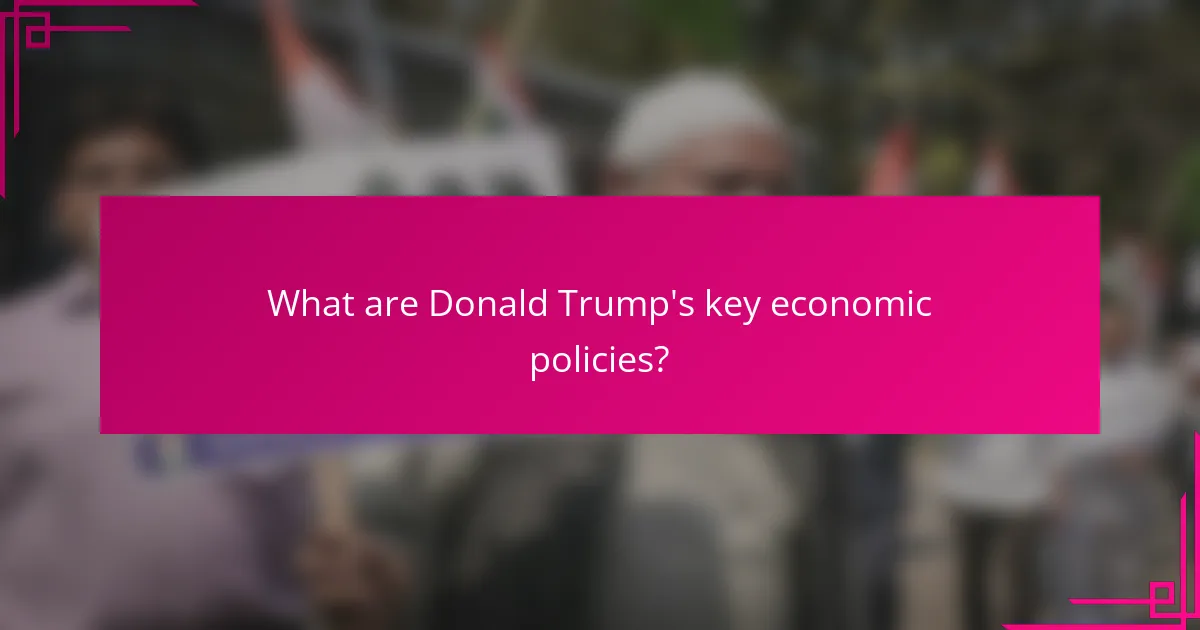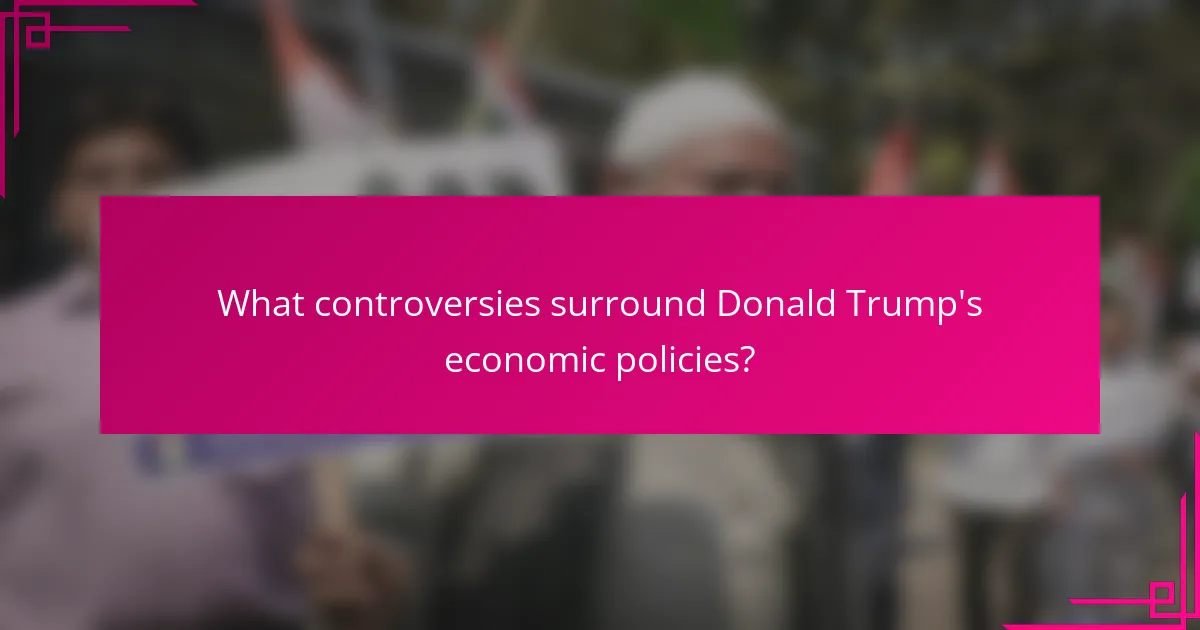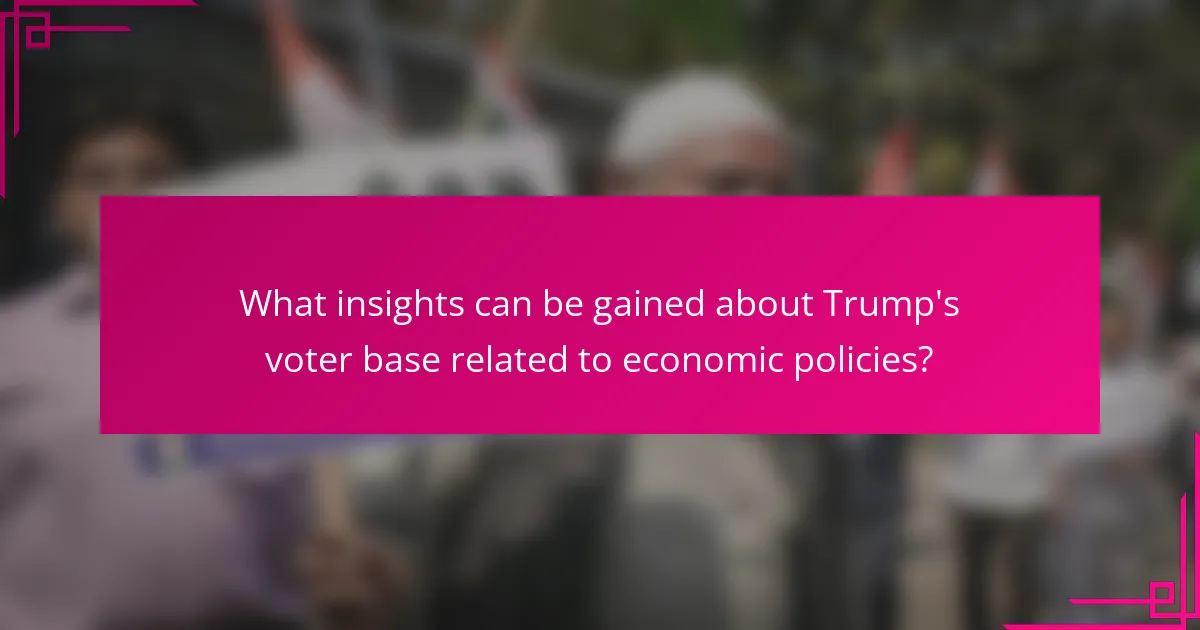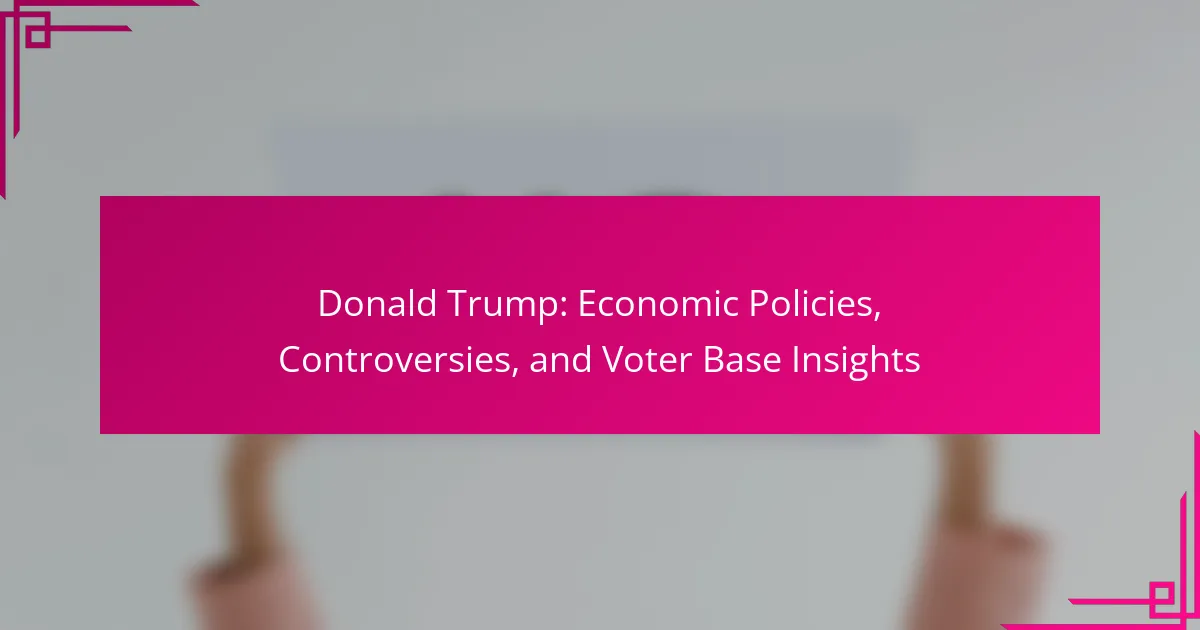Donald Trump’s economic policies encompass tax cuts, deregulation, and trade protectionism, significantly impacting the U.S. economy. The Tax Cuts and Jobs Act of 2017 reduced corporate tax rates from 35% to 21%, aiming to stimulate growth and job creation. Deregulation efforts targeted various industries, while trade protectionism was marked by tariffs on imports, particularly from China. These policies have sparked controversy, with critics highlighting their effects on income inequality, consumer prices, and environmental protections. Additionally, Trump’s handling of the COVID-19 pandemic has drawn criticism, influencing public opinion on his economic approach and resonating with his voter base that prioritizes economic nationalism and job creation.

What are Donald Trump’s key economic policies?
Donald Trump’s key economic policies include tax cuts, deregulation, and trade protectionism. His administration enacted the Tax Cuts and Jobs Act in 2017, which reduced corporate tax rates from 35% to 21%. This policy aimed to stimulate economic growth and increase job creation. Deregulation efforts focused on rolling back regulations across various industries, including environmental protections and labor laws. Trade protectionism was highlighted by tariffs imposed on imports from countries like China, aiming to protect American manufacturing. These policies were intended to boost domestic production and reduce trade deficits.
How do Trump’s tax policies impact the economy?
Trump’s tax policies significantly impact the economy by reducing corporate tax rates and altering individual tax brackets. The Tax Cuts and Jobs Act of 2017 lowered the corporate tax rate from 35% to 21%. This reduction aimed to incentivize business investment and stimulate economic growth. The act also modified individual tax rates, providing temporary tax cuts for many households.
These changes resulted in increased after-tax income for some individuals and higher profits for corporations. According to the U.S. Treasury, the economy grew at an annual rate of 2.9% in 2018, partly attributed to these tax cuts. However, critics argue that the tax cuts disproportionately benefited the wealthy and increased the federal deficit. The Congressional Budget Office projected a deficit increase of $1.9 trillion over ten years due to these policies.
Overall, Trump’s tax policies aimed to spur economic growth while also raising concerns about income inequality and fiscal sustainability.
What are the specific tax cuts introduced during Trump’s administration?
The specific tax cuts introduced during Trump’s administration include the Tax Cuts and Jobs Act of 2017. This legislation lowered the corporate tax rate from 35% to 21%. It also reduced individual income tax rates across various brackets. The act doubled the standard deduction for individuals and families. Additionally, it eliminated personal exemptions and capped the state and local tax deduction at $10,000. The legislation aimed to stimulate economic growth and increase wages. According to the Congressional Budget Office, these cuts were projected to add $1.9 trillion to the deficit over ten years.
How do these tax cuts affect different income groups?
Tax cuts primarily benefit higher-income groups more than lower-income groups. The Tax Cuts and Jobs Act of 2017 reduced the corporate tax rate from 35% to 21%. This change disproportionately favored wealthier individuals and corporations. According to the Tax Policy Center, in 2018, the top 1% of earners received an average tax cut of $51,000. In contrast, middle-income households received an average tax cut of about $930. Lower-income groups saw minimal benefits, often receiving little to no tax relief. Consequently, the income disparity widened as wealth concentrated among the affluent. Overall, tax cuts favored higher-income earners while providing limited relief to lower-income groups.
What role does trade policy play in Trump’s economic strategy?
Trade policy is a central component of Trump’s economic strategy. It focuses on protecting American industries and jobs. The strategy includes imposing tariffs on imports to encourage domestic production. For example, tariffs on steel and aluminum were implemented to support U.S. manufacturers. Trump’s administration aimed to renegotiate trade agreements, notably NAFTA, to favor American interests. The USMCA replaced NAFTA, reflecting this approach. Additionally, trade policy sought to address trade imbalances with countries like China. The administration accused China of unfair trade practices and intellectual property theft. Overall, trade policy under Trump aimed to prioritize American economic interests and reduce dependency on foreign goods.
What are the main features of Trump’s trade agreements?
Trump’s trade agreements primarily focus on renegotiating existing deals to favor American interests. Key features include the replacement of NAFTA with the USMCA, which aims to increase U.S. agricultural exports and strengthen labor provisions. Additionally, tariffs were imposed on various countries, particularly China, to address trade imbalances. These tariffs were intended to protect American manufacturing jobs. The agreements emphasize bilateral negotiations over multilateral frameworks. They also include provisions for intellectual property protection and dispute resolution mechanisms. Overall, Trump’s trade policies aimed to prioritize American workers and reduce trade deficits.
How have tariffs implemented by Trump influenced domestic industries?
Tariffs implemented by Trump have significantly influenced domestic industries by increasing costs for manufacturers and consumers. The tariffs, particularly on steel and aluminum, aimed to protect American jobs but led to higher prices for raw materials. This resulted in increased production costs for industries reliant on these metals, such as automotive and construction. For example, the U.S. auto industry faced an estimated $1 billion increase in costs due to tariffs. Additionally, retaliatory tariffs from other countries affected U.S. agricultural exports, hurting farmers. The overall impact was a mixed effect on job creation, with some sectors benefiting while others faced layoffs.
What is Trump’s approach to job creation and unemployment rates?
Trump’s approach to job creation focuses on tax cuts, deregulation, and trade policies. He implemented the Tax Cuts and Jobs Act in 2017, which aimed to stimulate economic growth. This act reduced corporate tax rates from 35% to 21%. He emphasized deregulation to encourage business expansion and job growth. Under his administration, unemployment rates reached a low of 3.5% in February 2020. Trade policies included renegotiating NAFTA into the USMCA to protect American jobs. His administration promoted “America First” policies to prioritize domestic employment. These strategies aimed to create millions of jobs and reduce unemployment.
What initiatives were introduced to boost employment during Trump’s presidency?
The Trump administration introduced several initiatives to boost employment. Key initiatives included the Tax Cuts and Jobs Act of 2017. This legislation aimed to reduce corporate tax rates, encouraging businesses to invest and hire more workers. Additionally, the administration focused on deregulation, rolling back numerous regulations to ease the burden on businesses. Programs like the Opportunity Zone initiative were created to incentivize investment in economically distressed areas. The administration also emphasized workforce development through initiatives like the Pledge to America’s Workers, which aimed to create millions of training opportunities. These measures contributed to a historically low unemployment rate prior to the COVID-19 pandemic.
How does Trump’s administration compare to previous administrations in job growth?
Trump’s administration saw job growth of approximately 6 million jobs from January 2017 to March 2020. This growth rate was lower than that of previous administrations. For instance, during Obama’s second term, around 11 million jobs were created. In contrast, Bush’s administration added about 8 million jobs during his two terms. Job growth under Trump was affected by the COVID-19 pandemic, leading to significant job losses in 2020. Overall, while Trump’s administration experienced growth, it was comparatively less robust than the job growth seen in preceding administrations.

What controversies surround Donald Trump’s economic policies?
Donald Trump’s economic policies have sparked several controversies. Critics argue that his tax cuts disproportionately benefited the wealthy. The Tax Cuts and Jobs Act of 2017 reduced corporate tax rates from 35% to 21%. This led to increased deficits, with the Congressional Budget Office projecting a $1.9 trillion increase in the deficit over ten years.
Additionally, Trump’s trade policies, particularly tariffs on China, faced backlash. These tariffs led to higher consumer prices and strained international relations. Many economists warned that the trade war could harm American farmers and manufacturers.
Another point of contention is his deregulation efforts. Supporters claim deregulation spurred economic growth. However, opponents argue it jeopardized environmental protections and public health. The rollback of regulations during his administration raised concerns among environmentalists and health advocates.
Lastly, Trump’s handling of the COVID-19 pandemic and its economic fallout drew significant criticism. Many believe his administration’s response was inadequate, leading to prolonged economic challenges. This multifaceted approach to economic policy has left a divided public opinion.
What criticisms have been raised against Trump’s tax reforms?
Critics have raised concerns that Trump’s tax reforms disproportionately benefited the wealthy. The Tax Cuts and Jobs Act of 2017 lowered the corporate tax rate from 35% to 21%. This change was seen as favoring large corporations over middle-class families. Additionally, the reforms increased the federal deficit by approximately $1.9 trillion over ten years. Critics argue that these tax cuts did not lead to the promised economic growth. Many small businesses did not see significant benefits. The reforms also eliminated certain deductions that affected taxpayers in high-tax states. Overall, the criticisms highlight issues of equity and fiscal responsibility related to the tax reforms.
How do economists view the long-term effects of these reforms?
Economists generally view the long-term effects of Donald Trump’s economic reforms as mixed. Some experts argue that tax cuts and deregulation spurred short-term growth. For instance, the Tax Cuts and Jobs Act of 2017 aimed to increase investment and wages. However, critics highlight the potential for increased national debt and income inequality. They point to projections indicating that the benefits may not be sustainable. Additionally, tariffs imposed on imports could lead to trade tensions affecting economic stability. Overall, the long-term implications remain debated among economists, with varying perspectives on growth versus potential risks.
What are the implications of tax cuts for federal revenue?
Tax cuts generally reduce federal revenue in the short term. When tax rates are lowered, individuals and businesses retain more income. This can lead to increased consumer spending and investment. However, the immediate effect is a decrease in the funds available for government programs. According to the Congressional Budget Office, tax cuts can lead to increased deficits if not offset by spending cuts or increased revenue elsewhere. Over time, proponents argue that tax cuts can stimulate economic growth, potentially increasing revenue in the long run. Historical examples show mixed results, with some tax cuts leading to revenue increases and others contributing to larger deficits.
How has Trump’s trade policy affected international relations?
Trump’s trade policy has significantly altered international relations. His administration implemented tariffs on imports, particularly from China. This led to a trade war, affecting global supply chains. Countries like Canada and Mexico faced renegotiated trade agreements. The US-Mexico-Canada Agreement replaced NAFTA, changing trade dynamics in North America. Relations with traditional allies strained due to unilateral trade actions. Countries responded with retaliatory tariffs, impacting bilateral ties. Overall, Trump’s trade policy fostered a more protectionist global environment.
What backlash has Trump faced from foreign governments regarding tariffs?
Trump has faced significant backlash from foreign governments regarding tariffs. Many countries, including China, Canada, and the European Union, opposed his tariff policies. They argued that these tariffs disrupted global trade and harmed their economies. In response, China implemented retaliatory tariffs on U.S. goods, affecting American exporters. Canada and the EU also imposed tariffs on U.S. products, targeting key industries like steel and agriculture. This led to strained diplomatic relations and trade negotiations. The World Trade Organization received complaints from multiple nations about the legality of Trump’s tariffs. Overall, the backlash highlighted the tensions in international trade relations during his administration.
How have trade wars impacted American consumers and businesses?
Trade wars have increased costs for American consumers and businesses. Tariffs imposed on imported goods raise prices for products such as electronics and clothing. For example, the U.S. imposed tariffs on Chinese goods, leading to a 20% increase in prices for some consumer electronics. Businesses face higher costs for raw materials and components, impacting their profit margins. This has resulted in some companies passing on these costs to consumers. Additionally, uncertainty from trade wars can lead to reduced investment and hiring by businesses. A study by the National Bureau of Economic Research found that trade tensions have led to a decrease in U.S. GDP growth. Overall, trade wars create a ripple effect that burdens consumers and stifles business growth.
What controversies exist regarding Trump’s handling of the COVID-19 pandemic’s economic impact?
Controversies regarding Trump’s handling of the COVID-19 pandemic’s economic impact include criticism over the timing and effectiveness of stimulus measures. Critics argue that the initial response was slow, leading to greater economic fallout. The Paycheck Protection Program faced scrutiny for benefiting larger companies over small businesses. Additionally, Trump’s emphasis on reopening the economy raised concerns about public health risks. The administration’s messaging on mask-wearing and social distancing created confusion among the public. Economic recovery claims were often disputed by economists who pointed to rising unemployment rates. These controversies have contributed to polarized views on Trump’s overall economic management during the crisis.
What measures did Trump take to address economic challenges during the pandemic?
Trump implemented several measures to address economic challenges during the pandemic. He signed the Coronavirus Aid, Relief, and Economic Security (CARES) Act in March 2020. This act provided direct payments to individuals, amounting to $1,200 per [censured] and $500 per child. It also expanded unemployment benefits by an additional $600 per week. The CARES Act allocated $349 billion for the Paycheck Protection Program (PPP). This program aimed to help small businesses retain employees by providing forgivable loans. Additionally, Trump suspended federal student loan payments and interest accrual. He advocated for reopening the economy to stimulate growth. These measures aimed to provide immediate financial relief and support economic recovery during the pandemic.
How effective were these measures in supporting the economy?
The measures implemented during Donald Trump’s presidency were effective in supporting the economy. The unemployment rate reached a historic low of 3.5% in 2019. Tax cuts enacted in 2017 stimulated consumer spending and business investments. GDP growth averaged around 2.5% annually during his term. Additionally, the stock market hit record highs, reflecting investor confidence. These factors collectively contributed to economic expansion.

What insights can be gained about Trump’s voter base related to economic policies?
Trump’s voter base tends to prioritize economic nationalism and job creation. Many supporters value policies that promote American manufacturing and reduce reliance on foreign goods. These voters often resonate with tax cuts aimed at stimulating growth. Data from the 2016 election indicated that Trump attracted working-class voters in industrial regions. This demographic was particularly concerned with job losses in manufacturing sectors. Additionally, Trump’s promises of deregulation appealed to business owners seeking lower operational costs. Economic policies that emphasize immigration control also align with the interests of his voter base. Overall, Trump’s economic messaging has been effective in mobilizing support among those who feel economically marginalized.
What demographic groups make up Trump’s voter base?
Trump’s voter base consists primarily of white working-class voters, rural residents, and older adults. These groups significantly supported him in the 2016 and 2020 elections. White voters without a college degree made up a substantial portion of his support. Rural areas showed strong allegiance to his campaign messages. Additionally, older voters tended to favor Trump due to his stances on issues like Social Security and healthcare. According to exit polls, 57% of white voters and 52% of those aged 65 and older voted for him in 2020.
How do economic policies resonate with different segments of the electorate?
Economic policies resonate differently with various segments of the electorate based on their socioeconomic status and values. For instance, lower-income voters may prioritize policies that enhance job creation and raise the minimum wage. In contrast, higher-income individuals often favor tax cuts and deregulation.
Data from the 2020 election indicated that 60% of working-class voters supported economic policies focused on job growth. Conversely, affluent voters showed strong support for tax reforms that benefit wealthier individuals.
These trends highlight the diverse priorities among voters. Economic policies that directly address the needs of specific groups tend to garner more support. Understanding these differences is crucial for political strategies aimed at engaging distinct voter segments.
What role does economic performance play in voter support for Trump?
Economic performance significantly influences voter support for Trump. Strong economic indicators, such as low unemployment rates and rising GDP, often correlate with increased approval ratings for Trump. For instance, during his presidency, the unemployment rate dropped to 3.5% in 2019, the lowest in 50 years. This economic success bolstered his support among voters who prioritized job creation and economic stability. Conversely, economic downturns, like those seen during the COVID-19 pandemic, can lead to decreased voter support. Polls indicated that economic concerns were a primary factor in voter sentiment during the 2020 election. Thus, economic performance serves as a crucial determinant of Trump’s voter support.
How does Trump’s economic messaging appeal to his supporters?
Trump’s economic messaging resonates with his supporters through a focus on job creation and tax cuts. He emphasizes deregulation, claiming it boosts business growth. Many supporters believe his policies lead to higher wages and lower unemployment. The promise of revitalizing American manufacturing appeals to those in affected industries. His messaging often includes nationalistic themes that prioritize American workers. Supporters appreciate his straightforward communication style, which contrasts with traditional political rhetoric. Economic indicators during his presidency, such as stock market gains, bolster his claims. Overall, his messaging aligns with the economic aspirations of his base.
What themes are prevalent in Trump’s speeches regarding the economy?
Trump’s speeches regarding the economy often emphasize themes of job creation, tax cuts, and deregulation. He frequently highlights the importance of American manufacturing and energy independence. Trump often claims that his policies lead to economic growth and lower unemployment rates. He also discusses the need to prioritize American workers and businesses. Trade deals and tariffs are recurring topics, as he advocates for protecting U.S. industries. His speeches often reflect a populist approach, appealing to middle-class concerns. Trump frequently contrasts his economic achievements with those of previous administrations. These themes resonate with his voter base, reinforcing his economic narrative.
How do Trump’s economic policies align with the values of his voter base?
Trump’s economic policies align with his voter base by emphasizing job creation and tax cuts. His administration focused on deregulation, which appealed to business-minded voters. The 2017 Tax Cuts and Jobs Act lowered corporate tax rates, benefiting many in his base. Additionally, his “America First” approach prioritized domestic manufacturing and energy independence. This resonated with voters in traditional industries who felt left behind. Overall, his policies were designed to stimulate economic growth and support American workers, reflecting the values of his supporters.
What lessons can be learned from Trump’s economic policies for future elections?
Lessons from Trump’s economic policies indicate the importance of tax cuts and deregulation. Tax cuts, such as the 2017 Tax Cuts and Jobs Act, aimed to stimulate growth and appeal to voters. Deregulation efforts targeted industries like energy and finance, promoting job creation. These strategies resonated with a significant portion of the electorate, particularly working-class voters. The focus on job growth and economic nationalism proved effective in rallying support. Future candidates may benefit from prioritizing similar economic themes. Understanding the impact of trade policies, such as tariffs on China, is also crucial for voter sentiment. Overall, emphasizing economic growth and job creation can influence future election outcomes.
How can future candidates effectively address economic concerns of voters?
Future candidates can effectively address economic concerns of voters by prioritizing transparent communication about their economic plans. They should provide clear explanations of how their policies will impact job creation and wage growth. Engaging with voters through town halls and social media can foster trust and understanding. Candidates must also present data to support their claims, such as statistics on unemployment rates or economic growth projections. Additionally, addressing local economic issues specific to constituents can enhance relatability. For example, discussing plans for infrastructure investment can resonate in areas with high unemployment. Providing solutions to inflation and cost of living increases is crucial. Lastly, showcasing successful case studies from their policies or similar policies in other regions can reinforce credibility.
What strategies could be employed to engage Trump’s voter base on economic issues?
Engaging Trump’s voter base on economic issues can be achieved through targeted messaging and policy alignment. Emphasizing job creation and economic growth resonates with this demographic. Highlighting tax cuts and deregulation as successful strategies from Trump’s administration can reinforce support. Utilizing local success stories can create a relatable narrative. Engaging through social media platforms where his base is active can enhance outreach. Hosting town hall meetings focused on economic topics fosters direct communication. Presenting clear, actionable economic plans can mobilize support. Data shows that personalized communication increases voter engagement.
Donald Trump is the central entity of this article, which examines his economic policies, associated controversies, and insights into his voter base. Key policies discussed include tax cuts, deregulation, and trade protectionism, particularly the Tax Cuts and Jobs Act of 2017, which aimed to stimulate economic growth but faced criticism for disproportionately benefiting the wealthy. The article also explores the impact of trade policies on international relations and domestic industries, as well as the effectiveness of Trump’s initiatives during the COVID-19 pandemic. Furthermore, it analyzes how Trump’s economic messaging resonates with different demographic groups within his voter base, highlighting the importance of economic nationalism and job creation in his political strategy.
